How to Read Tire Size (Metric and Flotation)
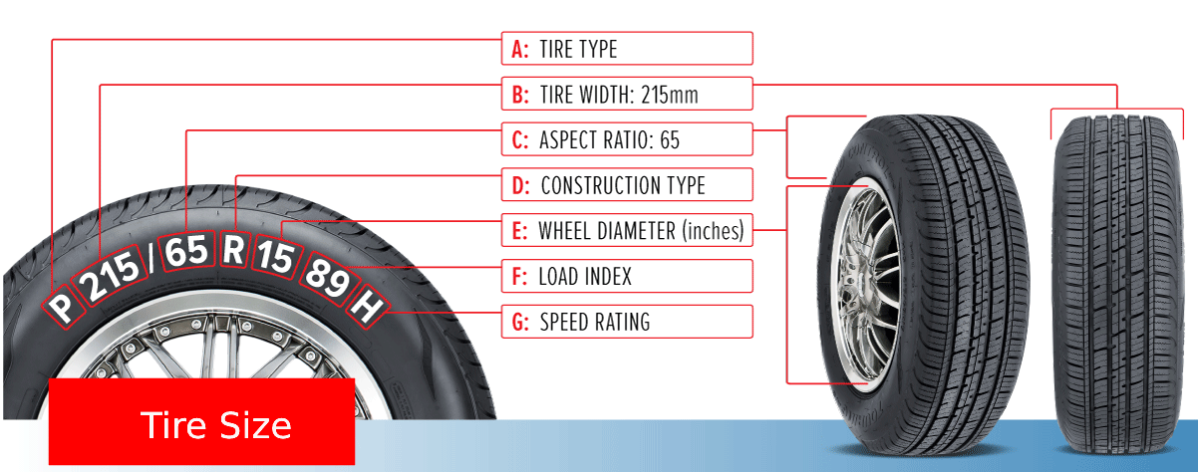
So you’ve decided to buy yourself a new set of tires, and here you are again – staring at the sidewall markings and tire sizing charts, trying to understand what the heck they mean and how to read tire size. Would you like to know exactly how to decode all these numbers and make a conscious choice?
Purchasing a new set of tires is a procedure that shouldn’t be rushed if you want to do it correctly. Tires vary in size and specifications, and there isn’t a one size fits all model.
With that in mind, this will be a guide to help you better understand tire size and specifications.
You’ll be an expert at reading and interpreting tire dimensions after reading this quick tutorial.
What Does Tire Size Mean?
Despite the name, tire size doesn’t specify just the dimensions of the tire. It is a list of specifications for each model that outlines the dimensions, load capacity, speed rating, and more.
The biggest problem that most people face is that apart from the measurements, they don’t know the other information relating to their tires. The specs are a combination of letters and numbers, which can get confusing. To help you with that, here’s a breakdown of each category. I will also explain what it means and how to identify it.
Where to Find Tire Size?
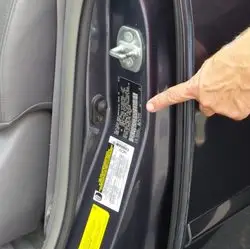
There are several ways to determine tire size. You can check your car’s manual or look at the sticker at the door or in the glove compartment. If you don’t have them, you can find the tire information on your existing tires’ sidewall.
Metric vs Flotation Tire Measurement Formats
Basically, there are two types of tire size measurement systems – metric and flotation.
Speaking of tire size, people usually imply the metric system as it comprises the majority of tires for passenger vehicles though it is also more complex for understanding.
Flotation tires is an alternative system of tire sizing. Designed to “float” over sandy terrain and loose sediment, the flotation principle became the core technology behind the off-road and all-terrain tires for trucks and SUVs as well.

What’s the difference between a flotation and a metric tire?
It would be easier to explain using the example. Let’s take the metric tire size of 295/75R16 and its flotation counterpart – 33.4×11.6R16. Check out the charts below.
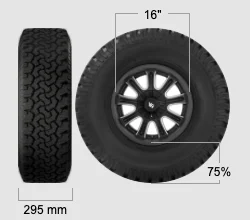
295/75R16 tires have a section width of 295 millimeters, a 75% aspect ratio, and fit 16-inch rims.
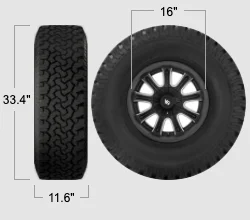
33.4×11.6R16 tires have a diameter of 33.4″, a section width of 11.6″, and a wheel diameter of 16″
It all boils down to the units of measurement. Flotation tire size is fully indicated in inches, while the metric tire size format utilizes millimeters, per cents, and inches to measure the diameter. Luckily, almost every flotation tire size has a metric equivalent.
The problem is neither of the systems clearly states the sidewall height. The metric size shows the sidewall height as the percentage of the tire width in millimeters, so you first need to calculate it in millimeters and then convert it to inches. While the flotation size does not specify the sidewall at all, it clearly reveals the overall tire height which is convenient for light truck and SUV owners.
How to Read Metric Tire Size Labels
It is a lot easier to grasp the idea behind numbers and letters on the sidewall by making use of the real-life tire size (P215/65R15 89H, for instance) and make use of graphic explanations.
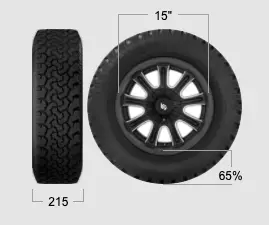
If you have no time to read in-depth descriptions, here is a quick answer.
Tire class: P (Passenger)
Section Width : 215 (millimeters)
Aspect Ratio : 60 (% of section width)
Tire Construction : R (Radial)
Wheel Diameter : 15 (fits 15-inch rims)
Load Index : 89 (max – 1279 lbs)
Speed Rating : H (speed limit – 129 mph)
Tire Class
The first category is the class determining what tire can be used for and the type of vehicle it can be mounted on. Class is the first letter in the string, and there are a few varieties.
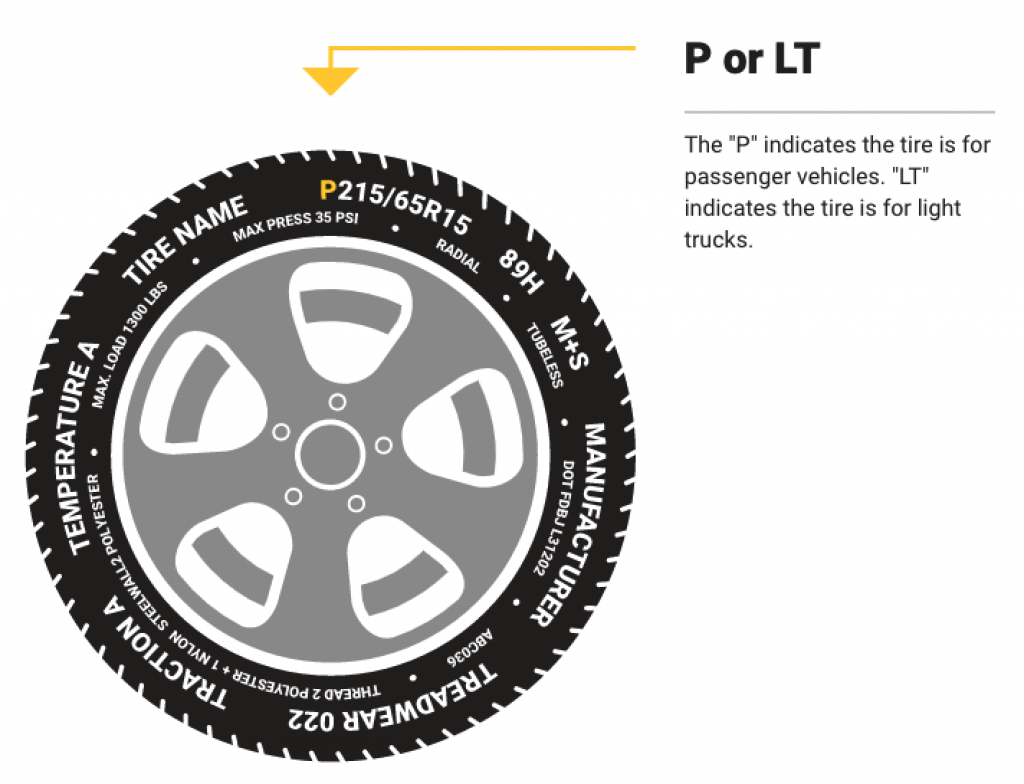
First is P-metric, which stands for passenger cars. Despite that, you can use this tire on SUVs, minivans, or light trucks that are not designed to carry heavy loads.
Next is LT-metric tires designed for SUVs or trucks that are designed for carrying loads. Be extra careful with this, as you may find P and LT tires for the same SUV or truck model.
If you see ST on the side of your tire, it means that you are looking at a tire made as a particular trailed model. You can find these tires on a trailer or trucks that can pull the weight of a trailer.
C is not something you’ll see on a passenger car. These tires are designed chiefly for vans or other kinds of vehicles, primarily designed for heavy loading.
If you ever had a flat tire, you likely replaced it with a T tire. These are temporary tires that are supposed to be used only in the case of a flat. People often call them space savers of donuts.
Section Width
The next piece of information you’ll find on the side of a tire is the dimensions and construction. Each tire has three numbers for the dimensions and a letter for the construction.
The first number is the one that determines the width of your tire. This is a 3-digit number, and the unit used is millimetres and identifies the tire’s width from one sidewall to the other.
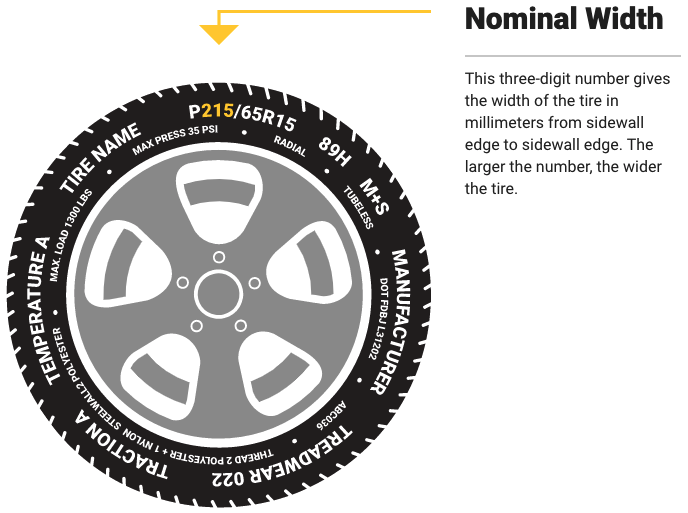
Next up is the sidewall height, which identifies the aspect ratio. The sidewall height is a percentage of the tire’s width.
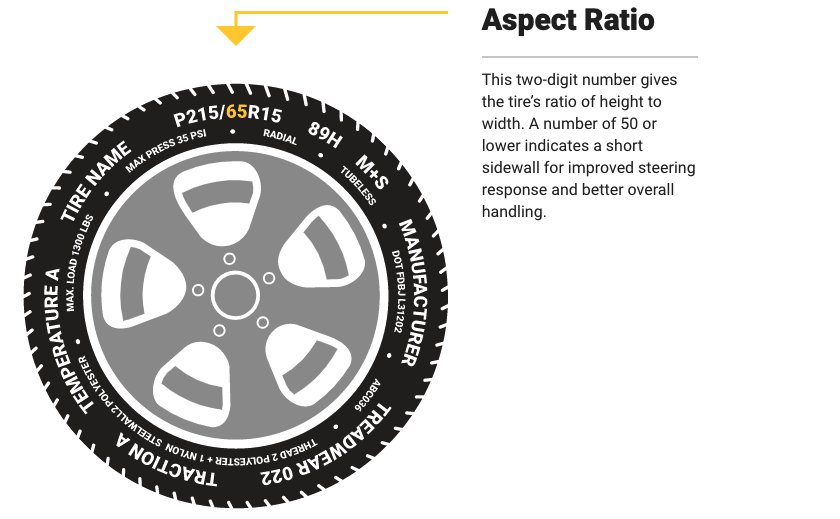
Following the numbers is a letter, which identifies the tire’s construction. In most cases, the tire will be R, meaning that it has radial construction. D stands for diagonal construction of the plies, and B is for belted construction. While you may come across D tires, the B ones are the least common ones.
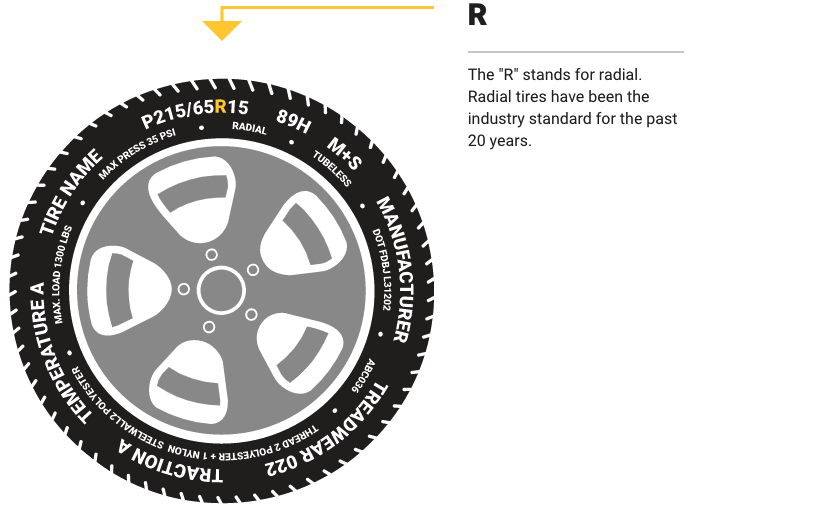
The last number is the diameter. It is a number that determines the size of the hole where the rims are supposed to be—the unit used for the diameter in inches.
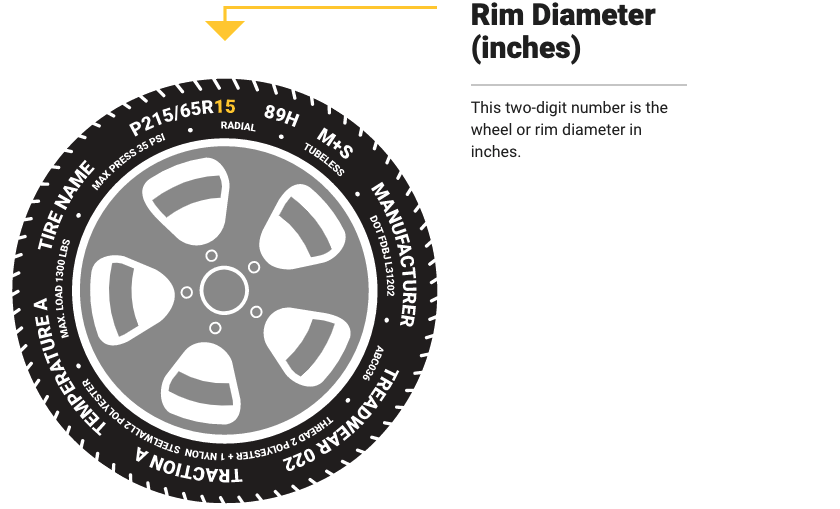
For example, if you have “P195/70R13,” it means that you have a tire for a passenger car, with a width of 195 millimetres, a height that is 70% from the width, a radial tire with a diameter of 13 inches.
Load Index
The load index identifies the maximum load information that one tire can handle before becoming unsafe to drive. It consists of 2 numbers that are linked with the weight based on a chart. In most modern cars, the load index can be from 70 to 150, but you may find tires with more than that. For example, if the tire’s load index is 100, the maximum weight a tire can hold is 1764 pounds.
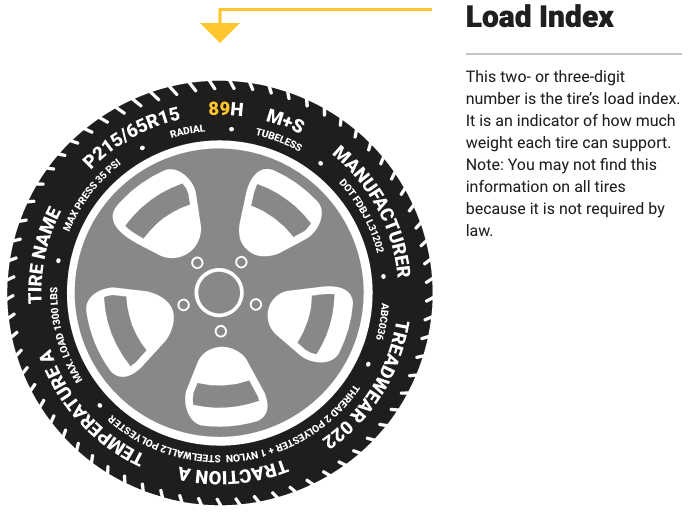
Tire load index chart
| Load Index | Max Weight (lbs) | Max Weight (kg) |
| 70 | 739 | 335 |
| 71 | 761 | 345 |
| 72 | 783 | 355 |
| 73 | 805 | 365 |
| 74 | 827 | 375 |
| 75 | 853 | 387 |
| 76 | 882 | 400 |
| 77 | 908 | 412 |
| 78 | 937 | 425 |
| 79 | 963 | 437 |
| 80 | 992 | 450 |
| 81 | 1019 | 462 |
| 82 | 1047 | 475 |
| 83 | 1074 | 487 |
| 84 | 1102 | 500 |
| 85 | 1135 | 515 |
| 86 | 1168 | 530 |
| 87 | 1201 | 545 |
| 88 | 1235 | 560 |
| 89 | 1279 | 580 |
| 90 | 1323 | 600 |
| 91 | 1356 | 615 |
| 92 | 1389 | 630 |
| 93 | 1433 | 650 |
| 94 | 1477 | 670 |
| 95 | 1521 | 690 |
| 96 | 1565 | 710 |
| 97 | 1609 | 730 |
| 98 | 1653 | 750 |
| 99 | 1709 | 775 |
| 100 | 1764 | 800 |
| 101 | 1819 | 825 |
| 102 | 1874 | 850 |
| 103 | 1929 | 875 |
| 104 | 1984 | 900 |
| 105 | 2039 | 925 |
| 106 | 2094 | 950 |
| 107 | 2149 | 975 |
| 108 | 2205 | 1000 |
| 109 | 2271 | 1030 |
| 110 | 2337 | 1060 |
| 111 | 2403 | 1090 |
| 112 | 2469 | 1120 |
| 113 | 2535 | 1150 |
| 114 | 2601 | 1180 |
| 115 | 2679 | 1215 |
| 116 | 2756 | 1250 |
| 117 | 2833 | 1285 |
| 118 | 2910 | 1320 |
| 119 | 2998 | 1360 |
| 120 | 3086 | 1400 |
| 121 | 3197 | 1450 |
| 122 | 3307 | 1500 |
| 123 | 3417 | 1550 |
| 124 | 3527 | 1600 |
| 125 | 3638 | 1650 |
| 126 | 3748 | 1700 |
Tire Speed Rating
Right next to the load index is the tire speed rating. It is presented as a letter and shows you the maximum speed at which a tire can be driven safely. Going over this number could reduce the performance or could lead to damage. Modern tires have 15-speed ratings, and they range from 75 mph to over 168 mph.
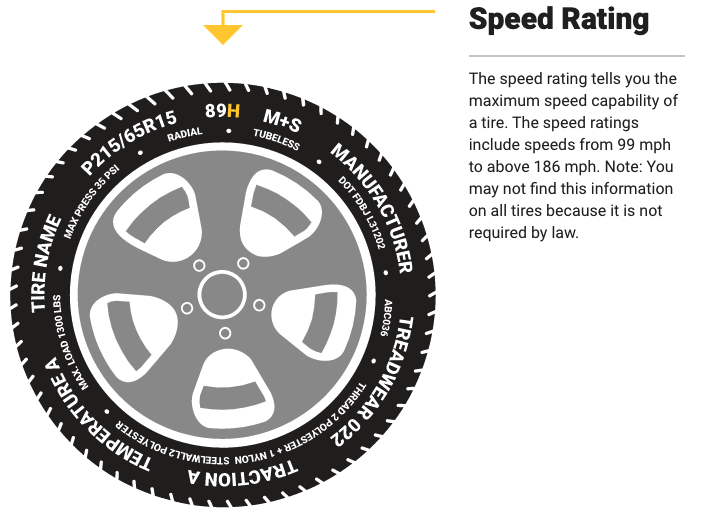
Tire Speed Rating Chart
| Speed rating | Miles per hour | KM per hour | Vehicle type |
| L | 75 mph | 120 km/h | Off-Road & Light Truck Tires |
| M | 81 mph | 130 km/h | Temporary Spare Tires |
| N | 87 mph | 140km/h | |
| P | 93 mph | 150 km/h | |
| Q | 99 mph | 160 km/h | Studless & Studdable Winter Tires |
| R | 106 mph | 170 km/h | H.D. Light Truck Tires |
| S | 112 mph | 180 km/h | Family Sedans & Vans |
| T | 118 mph | 190 km/h | Family Sedans & Vans |
| U | 124 mph | 200 km/h | |
| H | 130 mph | 210 km/h | Sport Sedans & Coupes |
| V | 149 mph | 240 km/h | Sport Sedans, Coupes & Sports Cars |
Tire Load Range
The last piece of information regarding the tire specification is the load range. There are some similarities to the load index, but it provides a different kind of information. The last two signs determine the maximum load it can carry at the maximum air pressure.
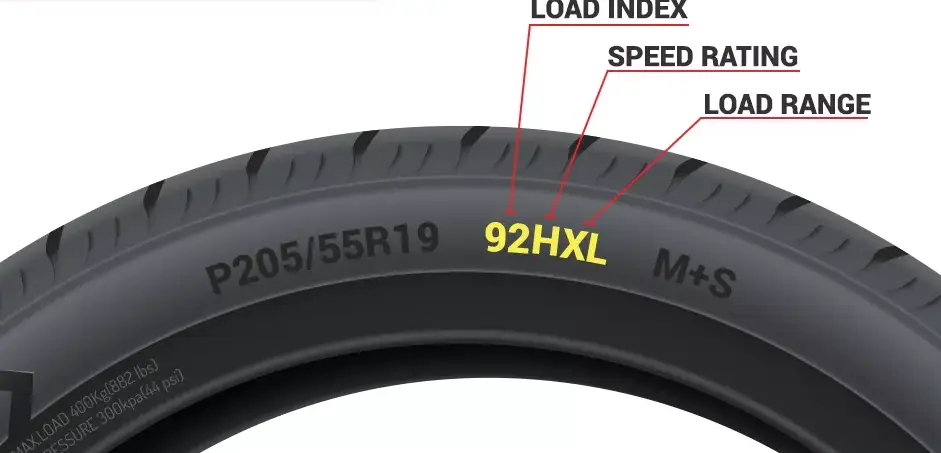
The P-metric tires can be ST, LL, or XL. ST are standard load, which are tires designed for cars that don’t need to carry any significant load.
You will rarely spot the tire load range labelling on a sedan, coupe, crossover or minivan wheels as they are usually equipped with the standard 4-ply tires, not intended for high-load capacities.
LL stands for light load and are tires that can be found on lighter trucks or SUVs that are capable of some light loads.
XL or extra load are tires that should be fitter on larger trucks designed to carry heavy loads. You may also find these labelled as RF or reinforced. ST and LL tires a rated at a maximum pressure of 35 psi, and XL or RF can go up to 41 psi.
LT-metric tires are for vehicles designed to carry heavy loads and hold much higher pressure than the regular P-metric ones. There are five types of LT tires, and they vary based on their ply rating. The lowest rating is 4-ply, while the highest is 12. The maximum pressure ranges from 35 to 95 psi.
Load Range and Ply Rating Chart
| Load Range | Ply Rating | Max Load Carrying Air Pressure |
| Standard Load (SL) | 4 | @ 36 PSI |
| Extra Load (XL) | 4 | @ 42 PSI |
| C1 | 6 | @ 50 PSI |
| C2 | 6 | @ 35 PSI |
| D1 | 8 | @ 65 PSI |
| D2 | 8 | @ 50 PSI |
| E1 | 10 | @ 80 PSI |
| E2 | 10 | @ 65 PSI |
| F1 | 12 | @ 95 PSI |
| G | 14 | @ 110 PSI |
Flotation Tires – How to Read Inch Sizes
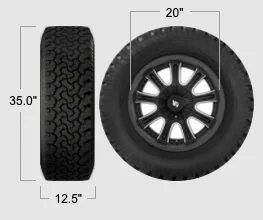
The example of the flotation tire size: 35X12.50R20 LT E
The short answer is: 35X12.50R20 tire has a diameter of 35.0″, a section width of 12.5″, and a wheel diameter of 20″.
The first two digits indicate the tire diameter in inches (35 in our example)
The next measurement is the section width, also calculated in inches (12.5).
The letter after the section width number tells us the tire construction (R – Radial, in our case). Radial tire construction is the industry standard for almost all modern tires.
Next to the right is the wheel diameter in inches (20) which means the tire should be mounted on the rims of 20-inch diameter.
It is followed by the tire class (LT stands for Light Truck).
The last letter denotes the Load Range of the tire (E – 10-ply thread, D: 8 ply, C: 6 ply, D: 4 ply).
References used:






